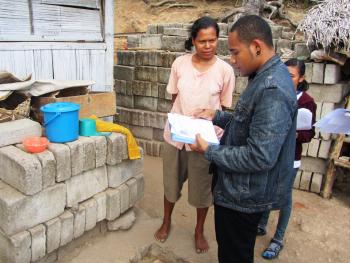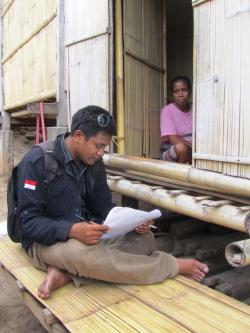In many parts of the world it is not done to ask questions about someone’s loo or toilet. It is not discussed among neighbours or friends. Usually that is the case in places where sanitation works perfectly and is not considered anything special.
Published on: 11/09/2014
A blog by Erick Baetings and Tettje van Daalen
However, in many places in the world sanitation is still a major problem and it is not just the toilet itself, but also the whole concept of hygiene and health that needs to be ingrained in people’s minds and lives. Educating people and continuous monitoring are important aspects for ensuring that improved hygiene and sanitation practices are adopted and sustained. Usually this process is done either via projects or government officials, but this is not always possible especially when you are working in vast areas, such as the Indonesian archipelago, where communities are spread over hundreds or thousands of islands. How do you keep track of progress or problems arising within such a vastly dispersed sanitation and hygiene programme?

In 2008 the Indonesian government set up a huge sanitation drive called STBM (Sanitasi Total Berbasis Masyarakat), a community-based approach for sanitation. STBM is based on 5 pillars:
To help roll out this programme at scale Simavi enrolled five Indonesian NGOs. The SHAW (Sanitation, Hygiene and Water) programme is implementing the STBM approach on five islands: Biak, Flores, Lombok, Sumba and Timor with the help of Simavi, Yayasan Rumsram, Yayasan Dian Desa, Yayasan Masyarakat Peduli, CD-Bethesda, Plan Indonesia and IRC. IRC has supported the programme in developing the current functioning performance monitoring system and built the capacity of the NGO partners to apply it effectively. The programme is expected to reach some 1.4 million people across more than 1,000 rural communities with sustainable sanitation and hygiene services.
The programme’s main aim is to realise sustained behaviour change and not just to increase access to facilities such as toilets and hand washing devices. It is therefore essential that both access to facilities and changes in behaviour and practices are monitored regularly. Frequent monitoring rounds are carried out to assess progress and to identify hick ups. Every 3 months 20,000 community volunteers visit more than 300,000 households.
No doubt readers will start frowning and think ‘this will not last, this is not sustainable, maybe only if you pay the volunteers’.
The Camat (sub-district head) explains that during the Kecamatan (sub-district) meeting "the monitoring results are used to follow the progress and based on them plans are made with the STBM village team to approach those that are not practicing STBM. During the meeting we can directly pinpoint which village or even which household is lagging behind and it is put on the target list. After the meeting the list is shared with each village and these households are visited".
But, it does work and has been working over the past three years without any payment. Every 3 months the volunteers visit their neighbours, friends, family and community members and ask them about the state of their toilet, how they use it, their hand washing facility and when they use it. In order to ensure that the data are reliable the programme has developed standard data collection questionnaires and pictograms to help the volunteers assess the situation correctly. Furthermore, training and on-the-job coaching is being provided to the volunteers by the NGO partners and sub-district sanitarians.

Monitoring is done in a participatory way. It is a sort of guided self-assessment. The volunteers visit a house and talk to the people living there. The indicators are explained by the volunteer and together with the people living in the house scores are assigned to the different indicators. In case of illiteracy or part illiteracy the pictograms help in explaining and scoring a particular situation. An added bonus of this whole process is that the members of the household realise their own situation. The monitoring visits provide a great opportunity for motivating and encouraging people to make improvements.
All the data so gathered is checked, cleaned and processed in the village and the resulting information is therefore immediately available at village level. This gives the village leaders regular insight into the STBM status of his village. Is there any progress? What are the trends, issues and patterns, and what are the problems? Keeping it close to home, involving everyone does bear fruit on the islands in the Indonesian archipelago. So the 3-monthly question: 'how are you and how is your loo?' is not a taboo. It is a life-saver.
At IRC we have strong opinions and we value honest and frank discussion, so you won't be surprised to hear that not all the opinions on this site represent our official policy.